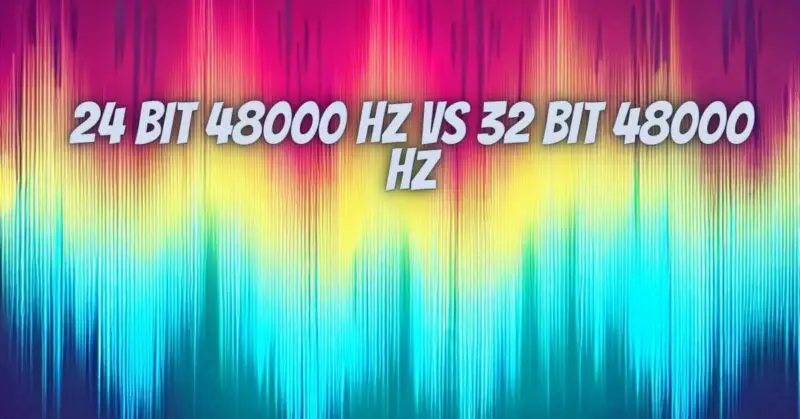24-bit 48000 Hz and 32-bit 48000 Hz are two different digital audio formats. The key difference between the two formats is the bit depth.
Bit depth refers to the number of bits used to represent each sample of the audio signal. A higher bit depth results in a more accurate representation of the original audio signal, and can capture a wider range of dynamic information.
- 24-bit audio uses 24 bits to represent each sample, resulting in a total of 16,777,216 possible values.
- 32-bit audio uses 32 bits to represent each sample, resulting in a total of 4,294,967,296 possible values.
This means that 32-bit audio has 256 times more possible values than 24-bit audio. This results in a more accurate representation of the original audio signal, and can capture a wider range of dynamic information.
Sampling rate refers to the number of times per second that the audio signal is sampled and converted into a digital signal. A higher sampling rate results in a more accurate representation of the original audio signal, and can capture more of the high-frequency information.
Both 24-bit and 32-bit audio can have a sampling rate of 48000 Hz. This means that both formats can capture the full range of human hearing.
Which format is better?
32-bit audio is generally considered to be better than 24-bit audio due to its higher bit depth. 32-bit audio can capture a wider range of dynamic information, resulting in a more realistic and immersive listening experience.
However, 24-bit audio is still a very good format, and most people will not be able to tell the difference between 24-bit and 32-bit audio. Additionally, 32-bit audio files are larger than 24-bit audio files, which can be important for storage and playback.
Which format should you use?
If you are serious about sound quality and are looking for the best possible listening experience, then you should use 32-bit audio. However, if you are on a budget or are not sure if you will notice a difference in sound quality, then 24-bit audio is a good choice.
Additional things to consider
- Your playback equipment: Not all playback equipment supports 32-bit audio. Make sure that your playback equipment supports 32-bit audio before you purchase 32-bit audio files.
- Your listening environment: The difference in sound quality between 24-bit and 32-bit audio is not always noticeable, especially in noisy environments. If you listen to music in a noisy environment, then you may not be able to tell the difference between 24-bit and 32-bit audio.
Ultimately, the best way to decide which format is right for you is to try both and see which one you prefer.
It is also important to note that the difference in sound quality between 24-bit and 32-bit audio is most noticeable in very high-quality recordings and playback equipment. If you are not using very high-quality recordings and playback equipment, then you may not be able to tell the difference between 24-bit and 32-bit audio.


